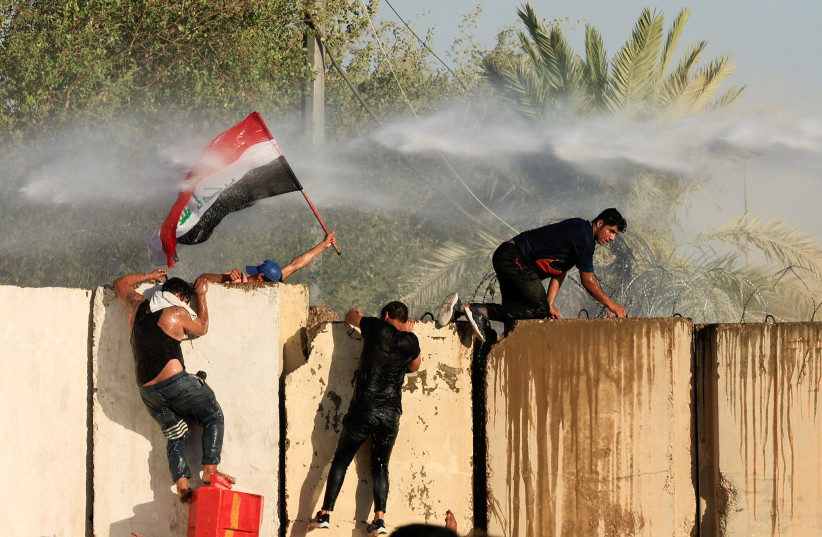Moqtada al-Sadr, a leader of a political movement in Iraq, is no stranger to protests. He has led many of them in Iraq over the last two decades. Now he is focused on US campus politics.
According to several reports the Iraqi leader, who is both a populist political figure and a religious leader, has called for the US to “halt to the crackdown on voices advocating for peace and freedom.” He said “the voice of American universities demanding an end to Zionist terrorism is our voice."
Sadr is only one of many people in the Middle East now focused on the protests sweeping US campuses. The fact that the protests are focused on the war in Gaza has led to an additional level of interest in the region. This is important because it gives many people a way to project their views of the region onto discussions of US politics.
Basically what that means is that they see the protests in the US and wonder if this means that in the future that US will be more pro-Palestinian. The fact that many of the protests are occurring on the campuses of academic institutions that are generally connected with producing the next generation of US leaders, especially diplomats for instance, means that countries in the region may see in the protests a broader shift in US policy in the future.
Regional calculations and miscalculations
This is important because this can lead to calculations and miscalculations in the region. When Hamas launched October 7 it likely did so after having watched the world’s response to Russia’s invasion of Ukraine and also after consultations with countries that host and back Hamas.
Hamas understood that the region and the world was changing. A new world order was emerging and the “rules” that applies in the past no longer apply.
That is why Hamas was able to massacre 1,000 people, more Jews since any massacre since the Holocaust, and today Hamas is backed by Russia, China, Qatar, Turkey, Iran and other countries. Hamas is received as if it is a state in meetings with Turkey’s leadership. Turkey is a NATO ally.
Hamas is hosted in Qatar, a major non-NATO ally of the US. In short, Hamas has powerful backers in the region, who are also allies of the West. The West has not sought to bring charges against Hamas leaders for October 7, basically showing there is indirect backing for Hamas at the highest levels in the West, and also at the campus level.
Hamas gambled on October 7, but it also has seen the wind blow strongly into the sails of a myriad of groups who back Hamas, including on campuses in the West. Other countries and voices are paying attention to this.
"The unfortunate images of the violent behavior of the American police against pro-Palestine university professors protesting the US policy of supporting the criminal Zionist regime has exposed to global judgment the gap between the US administration's slogans and actions," Iran foreign ministry spokesman Nasser Kana'ani wrote on Twitter, now known as X, on Friday.
He added that "American officials do not have the moral competence to make any comment about human rights, rights of women and the freedom of expression,” Iran’s Fars News noted.
Iranian media is taking a keen interest in the protests on US campuses. “Pro-Palestinian protests continued at major US universities through Friday evening decrying Israel's bombardment of Gaza, where Israel's genocidal war has so far killed more than 34,000 people, mainly children and women.
Throughout the week, several schools called police on protesters, leading to the arrests of hundreds across the country,” Iran’s Fars News also noted.
Al-Ain media in the UAE also focused on the protests. “The presidency of Columbia University, where the angry pro-Palestinian student movement began, announced that it had abandoned the dispersal of the gathering on campus by the New York Police, but one of the leaders of the movement was prevented from entering the university campus in northern Manhattan after statements shown in a video clip that were considered anti-Zionist,” the UAE-based media reported.
Another article at the same website compared the current protests to 1968 when protests against the Vietnam war swept US campuses. Countries in the region are watching this protest movement keenly. They are aware that in most countries in the region gatherings like those on US campuses would be quickly broken up.
Most of the region lacks basic rights to protest. Therefore there may also be a phenomenon where people in the region are inspired by the protests in the US, which they can live vicariously through.
For the pro-Iranian groups the protests will give them a sense that they should continue to pressure Israel via violence because they believe the US is now divided internally ahead of elections later this year in the US, and that they can exploit this to harm Israel’s ties with the US.
A lot of things are in motion in the region and globally, and the protests are being watched carefully in the Middle East.

